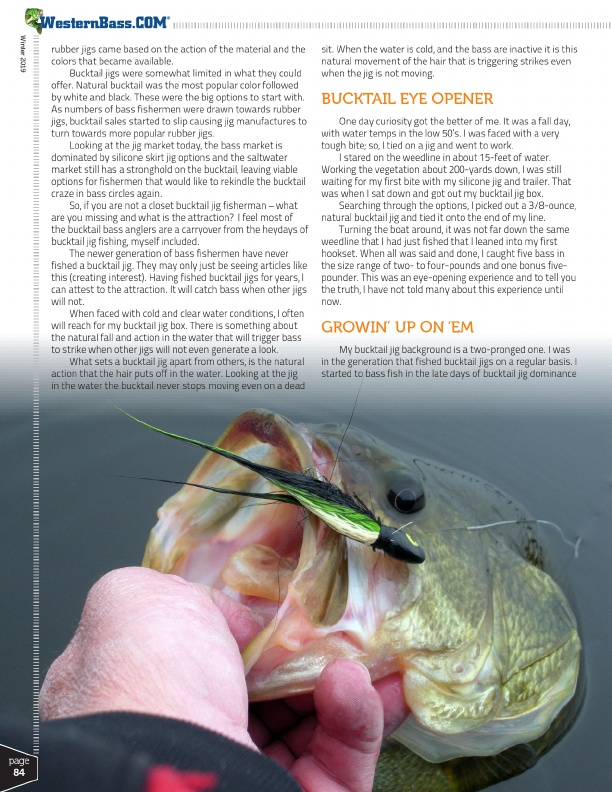
Winter 2019
®
rubber jigs came based on the action of the material and the colors that became available.
Bucktail jigs were somewhat limited in what they could offer. Natural bucktail was the most popular color followed by white and black. These were the big options to start with. As numbers of bass fishermen were drawn towards rubber jigs, bucktail sales started to slip causing jig manufactures to turn towards more popular rubber jigs.
Looking at the jig market today, the bass market is dominated by silicone skirt jig options and the saltwater market still has a stronghold on the bucktail, leaving viable options for fishermen that would like to rekindle the bucktail craze in bass circles again.
So, if you are not a closet bucktail jig fisherman – what are you missing and what is the attraction? I feel most of the bucktail bass anglers are a carryover from the heydays of bucktail jig fishing, myself included.
The newer generation of bass fishermen have never fished a bucktail jig. They may only just be seeing articles like this (creating interest). Having fished bucktail jigs for years, I can attest to the attraction. It will catch bass when other jigs will not.
When faced with cold and clear water conditions, I often will reach for my bucktail jig box. There is something about the natural fall and action in the water that will trigger bass to strike when other jigs will not even generate a look.
What sets a bucktail jig apart from others, is the natural action that the hair puts off in the water. Looking at the jig in the water the bucktail never stops moving even on a dead
sit. When the water is cold, and the bass are inactive it is this natural movement of the hair that is triggering strikes even when the jig is not moving.
BUCKTAIL EYE OPENER
One day curiosity got the better of me. It was a fall day, with water temps in the low 50’s. I was faced with a very tough bite; so, I tied on a jig and went to work.
I stared on the weedline in about 15-feet of water. Working the vegetation about 200-yards down, I was still waiting for my first bite with my silicone jig and trailer. That was when I sat down and got out my bucktail jig box.
Searching through the options, I picked out a 3/8-ounce, natural bucktail jig and tied it onto the end of my line.
Turning the boat around, it was not far down the same weedline that I had just fished that I leaned into my first hookset. When all was said and done, I caught five bass in the size range of two- to four-pounds and one bonus five- pounder. This was an eye-opening experience and to tell you the truth, I have not told many about this experience until now.
GROWIN’ UP ON ‘EM
My bucktail jig background is a two-pronged one. I was in the generation that fished bucktail jigs on a regular basis. I started to bass fish in the late days of bucktail jig dominance
page 84